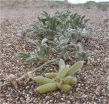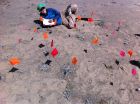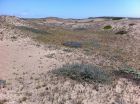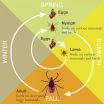Although dunes may look barren, they are actually reservoirs of biodiversity. "If you're a plant lover, the sand dunes are just spectacular," said Eleanor Pardini, PhD, assistant director of environmental studies at Washington University in St. Louis. Many plants and animals are adapted to living in the patchwork of open and stabilized microhabitats that characterized dunes subject to frequent wind disturbance, she said.
When the beachgrass spread, and the sand was locked in place, native plants and animals were threatened. "We knew many of the native dune plants were 'early successional species,'" Pardini said, "meaning that they relied on open areas of sand created by storm 'blowouts' for at least one part of their life cycle, and so struggled when the dunes remained undisturbed for long periods. But there was little quantitative data to document how much these plants actually relied on early habitats."
In the April 2 online edition of PLOS ONE, Pardini and her colleagues Kyle Vickstrom, then a Washington University undergraduate, and Tiffany Knight, PhD, associate professor of biology, published a demographic study of two endangered plants, Tidestrom's lupine (Lupinus tidestromii), and beach layia (Layia carnosa), at Point Reyes National Seashore north of San Francisco. Their work showed that these two species favor open sand and that the germination rate for lupine is far higher in recently disturbed open areas than in areas that already have plant cover. "It was exciting to put some numbers on the plants' need for disturbed habitat," Pardini said.
One reason is that the numbers strengthen the case for restoring the historical disturbance regime by removing the beachgrass and allowing the sand to move. "Our results suggest that large-scale restorations may be necessary to allow native plant species to persist," she said.
Plants are not the only dune species adapted to wind disturbance, she points out. Many rare species have evolved to take advantage of transient disturbances to their environment. For example, the Western snowy plover (Charadrius nivosus nivosus), another endangered dune species found at Point Reyes, selects sites with open sand for courtship and nesting.
Rescuing native species is not the only reason to restore the dunes, however. Beachgrass alters the topography of the dunes in ways that make them more vulnerable to erosion, Pardini said. "Native grasses are not as dense as beachgrass, so they allow some sand movement. The dune is a little bit mobile in its response to storm surges and strong tides.
"Beachgrass, on the other hand, creates tall, steep foredunes, with sand locked so tightly that the dunes are not able to withstand pummeling. Instead of absorbing strong wave action overwash, whole chunks of plant-bound dune just break off and fall into the ocean. You can see the edge of plant-bound dune creep inward, closer and closer to valuable farm land or standing structures," Pardini said.
The sandy life "To me, coming from the narrow beaches of the East Coast I'm familiar with, the dunes in California were just unbelievable," Pardini said. "They just go on forever. If you're in the middle, you can't see the ocean and you can't see the woodlands in the interior."
The dunes at Point Reyes house incredible species diversity, she said. And many of the native plants have made intriguing adaptations to the trials of life in the sand. For example, Tidestrom's lupine has hairy leaves that trap a thin layer of water-saturated air next to the leaf to slow down transpiration, she said.
Lupines, like other early successional plants, are also able to survive sand burial. "If you dig out the sand around little lupine leaves sticking out of a patch of blown sand, you sometimes find the leaves are attached to one of many branches that all go back to a much older plant," Pardini said.
Tidestrom's lupine seeds also have hard seed coats, which helps them stay viable even if they spend a long time buried in the sand. "In fact, the seed coat needs to be 'scarified' by tumbling in the sand if the seed is to germinate," Pardini said.
"I find the coastal dunes a really exciting place to consider how plants make their living," she said. "And as a side benefit there aren't that many snakes. Or ticks."
A sandy experiment How did Midwestern scientists end up doing research on the Californian dunes?
Pardini's co-author Tiffany Knight is an expert in a modeling technique called population viability analysis that can be used to project potential trajectories of an endangered population of plants or animals under different management schemes, given some assumptions about birth and death. Each run of the model is essentially an if-then experiment: if a management action alters birth or death rates in a particular way, would the population thrive and increase or dwindle and die away?
When Knight came to Washington University in 2005, she searched for new research challenges on critically endangered plant species. The vegetation ecologist at Point Reyes suggested she visit because the National Seashore has many rare or endangered plant species. Knight set up a few pilot projects in different ecosystems and the lupine project turned out to be one of the most interesting.
"I keep coming back to Point Reyes because I appreciate the relationship that I have with the National Seashore," Knight said. "The seashore is genuinely interested in incorporating scientific research findings into habitat management and it has also been an inspiring place to train undergraduate students. Many of the undergraduates I have taken with me to Point Reyes have gone on to graduate school in ecology and conservation science."
"This summer will be our eleventh year of continuous demographic data collection on Tidestrom's lupine at three locations at Point Reyes," Pardini said. "So we're starting to get a really powerful dataset on this species."
For the PLOS ONE study, the scientists surveyed vegetation in 145 randomly chosen meter-square plots in the dunes near Abbott's Lagoon, an area in Point Reyes that hosts the largest remaining population of Tidestrom's lupine.
"We recorded the presence or absence of beach layia and Tidestrom's lupine, and in the case of Tidestrom's lupine, which is a perennial, the plant's lifestage. Analysis of this data showed that both rare plants occur more frequently in open sand than would be expected by chance, and that seedlings of Tidestrom's lupine particularly favored open patches.
"Our model shows that the population growth rate of Tidestom's lupine is higher in early habitats than late habitats, primarily because seedling germination is higher there," Pardini said.
The scientists hope their accumulating data on Tidestrom's lupine and other endangered plants will be used to answer a broad set of management questions, one of the most important of which is how best to restore the native dune system, with its ability to bend, rather than break, before the wind.
"As climate change leads to more frequent storms, intense tides and extreme storm surges, it's really important to have the intact native dune in coastal areas," Pardini said.
INFORMATION:





